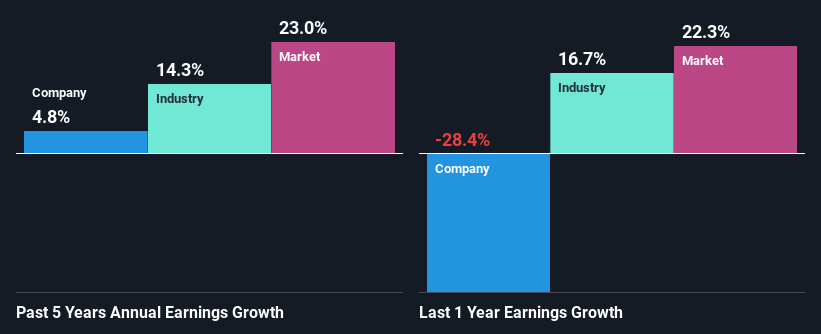Are K.M. Sugar Mills Limited's (NSE:KMSUGAR) Mixed Financials The Reason For Its Gloomy Performance on The Stock Market?

It is hard to get excited after looking at K.M. Sugar Mills' (NSE:KMSUGAR) recent performance, when its stock has declined 15% over the past three months. It is possible that the markets have ignored the company's differing financials and decided to lean-in to the negative sentiment. Long-term fundamentals are usually what drive market outcomes, so it's worth paying close attention. In this article, we decided to focus on K.M. Sugar Mills' ROE.
ROE or return on equity is a useful tool to assess how effectively a company can generate returns on the investment it received from its shareholders. In other words, it is a profitability ratio which measures the rate of return on the capital provided by the company's shareholders.
Check out our latest analysis for K.M. Sugar Mills
How To Calculate Return On Equity?
ROE can be calculated by using the formula:
Return on Equity = Net Profit (from continuing operations) ÷ Shareholders' Equity
So, based on the above formula, the ROE for K.M. Sugar Mills is:
7.6% = ₹229m ÷ ₹3.0b (Based on the trailing twelve months to June 2024).
The 'return' refers to a company's earnings over the last year. So, this means that for every ₹1 of its shareholder's investments, the company generates a profit of ₹0.08.
Why Is ROE Important For Earnings Growth?
Thus far, we have learned that ROE measures how efficiently a company is generating its profits. Depending on how much of these profits the company reinvests or "retains", and how effectively it does so, we are then able to assess a company’s earnings growth potential. Assuming everything else remains unchanged, the higher the ROE and profit retention, the higher the growth rate of a company compared to companies that don't necessarily bear these characteristics.
K.M. Sugar Mills' Earnings Growth And 7.6% ROE
As you can see, K.M. Sugar Mills' ROE looks pretty weak. Even when compared to the industry average of 11%, the ROE figure is pretty disappointing. Accordingly, K.M. Sugar Mills' low net income growth of 4.8% over the past five years can possibly be explained by the low ROE amongst other factors.
As a next step, we compared K.M. Sugar Mills' net income growth with the industry and were disappointed to see that the company's growth is lower than the industry average growth of 14% in the same period.

Earnings growth is an important metric to consider when valuing a stock. What investors need to determine next is if the expected earnings growth, or the lack of it, is already built into the share price. Doing so will help them establish if the stock's future looks promising or ominous. Is K.M. Sugar Mills fairly valued compared to other companies? These 3 valuation measures might help you decide.
Is K.M. Sugar Mills Using Its Retained Earnings Effectively?
K.M. Sugar Mills doesn't pay any regular dividends, which means that it is retaining all of its earnings. This doesn't explain the low earnings growth number that we discussed above. So there might be other factors at play here which could potentially be hampering growth. For example, the business has faced some headwinds.
Conclusion
Overall, we have mixed feelings about K.M. Sugar Mills. While the company does have a high rate of reinvestment, the low ROE means that all that reinvestment is not reaping any benefit to its investors, and moreover, its having a negative impact on the earnings growth. Wrapping up, we would proceed with caution with this company and one way of doing that would be to look at the risk profile of the business. Our risks dashboard would have the 2 risks we have identified for K.M. Sugar Mills.
Valuation is complex, but we're here to simplify it.
Discover if K.M. Sugar Mills might be undervalued or overvalued with our detailed analysis, featuring fair value estimates, potential risks, dividends, insider trades, and its financial condition.
Access Free AnalysisHave feedback on this article? Concerned about the content? Get in touch with us directly. Alternatively, email editorial-team (at) simplywallst.com.
This article by Simply Wall St is general in nature. We provide commentary based on historical data and analyst forecasts only using an unbiased methodology and our articles are not intended to be financial advice. It does not constitute a recommendation to buy or sell any stock, and does not take account of your objectives, or your financial situation. We aim to bring you long-term focused analysis driven by fundamental data. Note that our analysis may not factor in the latest price-sensitive company announcements or qualitative material. Simply Wall St has no position in any stocks mentioned.
About NSEI:KMSUGAR
K.M. Sugar Mills
Manufactures and sells sugar and industrial alcohol in India.
Solid track record with adequate balance sheet.
Market Insights
Community Narratives




